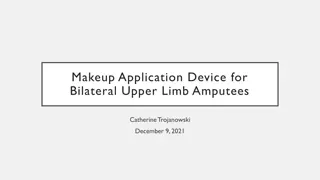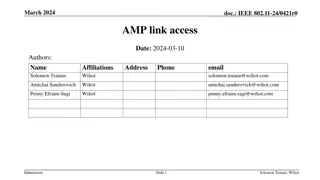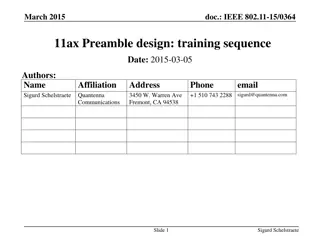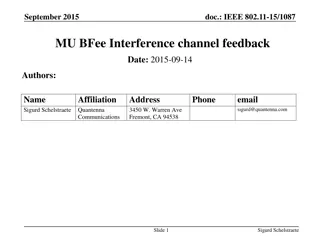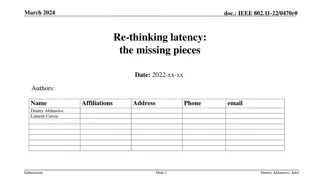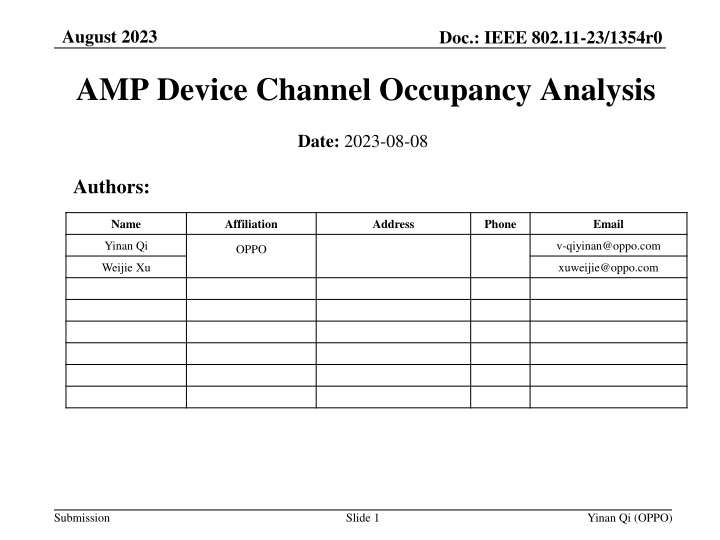
Channel Occupancy Analysis of AMP Devices in August 2023
Conducting a detailed analysis of channel occupancy for AMP devices in August 2023 based on IEEE 802.11-23/1354r0 documentation. The study covers various use cases such as smart manufacturing and indoor positioning, discussing device density, payload sizes, retransmission policies, and overall channel occupancy times. Observations indicate minimal impact on legacy devices despite potential peak occupancy scenarios. Findings aim to provide insights for optimizing device performance and network efficiency.
Download Presentation

Please find below an Image/Link to download the presentation.
The content on the website is provided AS IS for your information and personal use only. It may not be sold, licensed, or shared on other websites without obtaining consent from the author. If you encounter any issues during the download, it is possible that the publisher has removed the file from their server.
You are allowed to download the files provided on this website for personal or commercial use, subject to the condition that they are used lawfully. All files are the property of their respective owners.
The content on the website is provided AS IS for your information and personal use only. It may not be sold, licensed, or shared on other websites without obtaining consent from the author.
E N D
Presentation Transcript
August 2023 Doc.: IEEE 802.11-23/1354r0 AMP Device Channel Occupancy Analysis Date: 2023-08-08 Authors: Name Affiliation Address Phone Email Yinan Qi v-qiyinan@oppo.com OPPO Weijie Xu xuweijie@oppo.com Submission Slide 1 Yinan Qi (OPPO)
Doc.: IEEE 802.11-23/1354r0 August 2023 Abstract The purpose of this presentation is to analyse the channel occupancy of AMP devices. Submission Slide 2 Yinan Qi (OPPO)
August 2023 Doc.: IEEE 802.11-23/1354r0 Assumptions Considered typical use cases o Smart manufacturing: inventory and environment/production line sensing and monitoring o Indoor positioning: positioning in giant shopping mall, factories, warehouses, etc. Payload size o Inventory: 128 bits o Sensor: 96 bits o Positioning: 256 bits Signalling overhead: 50% Peak data rate: 51.2 kbps, 250 kbps, 1 Mbps Device density: 1.5 per m2, 10 per m2 Coverage: 10m Retransmission: no retransmission, packet is dropped when received incorrectly Submission Slide 3 Yinan Qi (OPPO)
August 2023 Doc.: IEEE 802.11-23/1354r0 Smart Manufacturing: Inventory Number of AMP devices associated with one AMP AP o Low density: 471 o High density: 3142 Channel occupancy time for data transmission for one AMP device o Low rate: 5 ms o Mid rate: 1 ms o High rate: 0.256 ms Overall channel occupancy time o Low density Low rate: 2.36 s Mid rate: 0.47 s High rate: 0.12 s o High density Low rate: 15.6 s Mid rate: 3.1 s High rate: 0.8 s Submission Slide 4 Yinan Qi (OPPO)
August 2023 Doc.: IEEE 802.11-23/1354r0 Smart Manufacturing: Inventory Number of Inventory per hour: 1/h, 0.1/h Overall channel occupancy percentage o 1/hour: 0.0033% - 0.4% o 0.1/hour: 0.00033% - 0.04% Observation 1: Overall channel occupancy time can be up to 15.6 s in a extreme case but the overall channel occupancy percentage is extremely small, e.g., up to 0.4%. Observation 2: For majority cases, overall channel occupancy time is expected to be from a few hundred milliseconds to a few seconds and have negligible impact on other legacy devices Submission Slide 5 Yinan Qi (OPPO)
August 2023 Doc.: IEEE 802.11-23/1354r0 Smart Manufacturing: Sensor Number of AMP devices associated with one AMP AP o Low density: 471 Channel occupancy time for data transmission for one AMP device o Low rate: 3.75 ms o Mid rate: 0.75 ms o High rate: 0.192 ms Overall channel occupancy time o Low density Low rate: 1.77 s Mid rate: 0.35 s High rate: 0.09 s Submission Slide 6 Yinan Qi (OPPO)
August 2023 Doc.: IEEE 802.11-23/1354r0 Smart Manufacturing: Sensor Number of sensor data reporting per hour: 10/h, 1/h, 0.1/h Overall channel occupancy percentage o 10/hour: 0.025% - 0.49% o 1/hour: 0.0025% - 0.049% o 0.1/hour: 0.00025% - 0.0049% Observation 1: Overall channel occupancy time is up to 1.77 s in a extreme case and has negligible impact on other legacy devices Observation 2: The overall channel occupancy percentage is extremely small, e.g., up to 0.49%. Submission Slide 7 Yinan Qi (OPPO)
August 2023 Doc.: IEEE 802.11-23/1354r0 Indoor Positioning: Positioning Number of AMP devices associated with one AMP AP o Low density: 471 Channel occupancy time for data transmission for one AMP device o Low rate: 10 ms o Mid rate: 2 ms o High rate: 0.512 ms Overall channel occupancy time o Low density Low rate: 4.72 s Mid rate: 0.94 s High rate: 0.24 s Submission Slide 8 Yinan Qi (OPPO)
August 2023 Doc.: IEEE 802.11-23/1354r0 Indoor Positioning: Positioning Number of Inventory per hour: 0.1/h Overall channel occupancy percentage o 0.1/hour: 0.00066% - 0.08% Observation 1: Overall channel occupancy time is up to 4.72 s in a extreme case but the overall channel occupancy percentage is extremely small, e.g., up to 0.08%. Observation 2: For majority cases, overall channel occupancy time is expected to be from a few hundred milliseconds to a few seconds and have negligible impact on other legacy devices Submission Slide 9 Yinan Qi (OPPO)
August 2023 Doc.: IEEE 802.11-23/1354r0 Summary Base on the analysis, only in some extreme case, e.g., low rate and high density smart manufacturing, deployment of AMP devices August affect legacy devices during the peak time. However, such case is normally special case and isolated from other legacy devices. For other use cases, the overall channel occupancy time is only up to a few seconds and the overall channel occupancy percentage is less than 0.5%. In majority cases, the impact of AMP devices to legacy devices is negligible. Submission Slide 10 Yinan Qi (OPPO)




